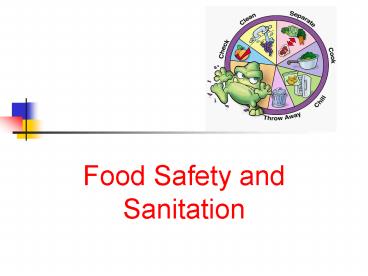Food Safety and Sanitation - PowerPoint PPT Presentation
1 / 23
Title:
Food Safety and Sanitation
Description:
Food Safety and Sanitation Next Generation Science / Common Core Standards Addressed! CCSS. Math. Content.HSS ID.A.2 Use statistics appropriate to the shape of the ... – PowerPoint PPT presentation
Number of Views:1667
Avg rating:3.0/5.0
Title: Food Safety and Sanitation
1
- Food Safety and Sanitation
2
Next Generation Science / Common Core Standards
Addressed!
- CCSS. Math. Content.HSS-ID.A.2 Use statistics
appropriate to the shape of the data distribution
to compare center (median, mean) and spread
(interquartile range, standard deviation) of two
or more different data sets. - CCSS. ELA Literacy.WHST.11-12.6 Use technology,
including the Internet, to produce, publish, and
update individual or shared writing products in
response to ongoing feedback, including new
arguments or information.
3
Bell Work / Student Learning Objectives
- Explain the causes of food-borne illnesses.
- Describe methods for preventing food-borne
illnesses. - Explain procedures used in food sanitation.
- Explain the Hazard Analysis and Critical Control
Point (HACCP) System.
4
Terms
- Cleaning
- Food-borne illness
- Food-borne infection
- Food-borne intoxication
- Food sanitation
- HACCP (Hazard Analysis and Critical Control
Point) - Metabolites
- Pathogen
- Personal hygiene
- Sanitizing
5
Interest Approach
- What type of items are worn by workers in fast
food restaurants? - What signs are posted in the restaurant that
relate to worker hygiene? - Why?
6
Food-borne illnesses
- Food-borne illness is sickness in humans caused
by a pathogen. - A pathogen is a microorganism that inflicts
illness in humans. - A food-borne illness is rarely life threatening.
It can, however, cause great discomfort in humans.
7
Food-borne illness can be traced to two basic
causes
- Food-borne infection is caused by ingesting a
microorganism in a contaminated food source. - Food-borne intoxication is an illness that is
caused by consuming a food that contains harmful
metabolites from a microorganism.
8
What procedures can be used to prevent food-borne
illnesses?
- Preventing food-borne illness is fairly easy.
- Using common sense and a few basic procedures,
both food processors and homeowners can enjoy
safe foods.
9
Safety procedures
- Food temperature- match temp. to product.
- Ensure proper cooking temperature.
- Separate cooked and uncooked foods.
- Wash hands and use utensils.
- Marinate in the refrigerator.
10
What procedures are employed to insure
cleanliness in the food processing environment?
- Food sanitation is the overall cleanliness and
hygiene in the food processing environment. - This includes the cleanliness of the equipment
used in a food processing plant and the hygiene
of the workers using the equipment.
11
Sanitation is critical!
12
Environment
- The food preparation environment is kept safe
through - Waste removal
- Cleaning and sanitizing
13
Personal hygiene
- Personal hygiene involves keeping the following
clean - Clothing
- Hands
- Hair
- Footwear
- Floor and Work Surfaces
14
What is HACCP and why was it established?
- HACCP - Hazard Analysis and Critical Control
Point - HACCP is a program designed to analyze every food
processing system for its key production points
and points of contamination.
15
HACCP
- HACCP was developed jointly by the U.S. Army and
The Pillsbury Company. - It is administered by the United States
Department of Agriculture
16
HACCP is guided by seven basic principles
- Assess all potential hazards from the growing
stage through the preparation stage. - Determine critical points where controls are
necessary to reduce hazards. - Establish requirements to be met at each critical
point.
17
HACCP is guided by seven basic principles
- Establish procedures to monitor each critical
point. - Establish corrective procedures when monitoring
uncovers problems. - Establish record-keeping procedures.
- Establish procedures to monitor the effectiveness
of the plan.
18
In establishing a HAACP program, a food
processors goal is to meet three basic
objectives
- To destroy, eliminate, and reduce hazards.
- To prevent recontamination of the food product.
- Inhibit the growth and production of any toxins
that may be present.
19
Hazards must be identified and ranked according
to the following system
- Hazard A - applies to products designated for
consumption by at-risk populations. - At-risk populations include infants and the
elderly. - Hazard B - applies to products containing
ingredients known to be toxic.
20
Hazards must be identified and ranked according
to the following system
- Hazard C - the process used does not contain a
step that effectively controls the toxin
identified. - Hazard D - applies to products that are subject
to recontamination after processing and before
packaging.
21
Hazards must be identified and ranked according
to the following system
- Hazard E - applies to products that have a
substantial potential for contamination in
distribution or consumer handling that could
render the product harmful.
22
Review/Summary
- How are food-borne illnesses caused?
- What procedures can be used to prevent food-borne
illnesses? - What procedures are employed to insure
cleanliness in the food processing environment? - What is HACCP and why was it established?
23
The End!































